March 30, 2009
New Zealand: West Coast
I'm in the Paparoa National Park in the West Coast of NZ, shortly to depart for Kahurangi National Park, further north. Currently I am at Punakaiki, known by tourists for its Pancake Rocks. I was here last year
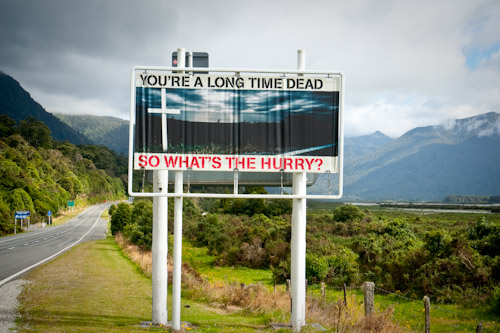 Gary Sauer-Thompson, West Coast, Southn Island, New Zealand
Gary Sauer-Thompson, West Coast, Southn Island, New Zealand
I am on the margins of the global tourism circuit, as I'm off the beaten global tourism track and entering backbacker territory. This is largely bushwalking territory in what could be called wilderness areas---luxuriant coastal forest, limestone cliffs and canyons, caves and flowing rivers and creeks. There is water everywhere, even at the end of summer.
The photography is difficult in the luxuriant bush behind the coastal strip along the coast because of the low light in the river beds and in the coastal rain forest. It is all hand held--digital and film--- as I decided not to lug a tripod around.
March 29, 2009
Bonds
barbed wire, bare female flesh and underwear:
It is a view from an alley way in Melbourne's CBD. Guildford Lane, if I remember.
March 28, 2009
Sunday humor
It is a British cartoon, but a New Zealand reality unfortunately:
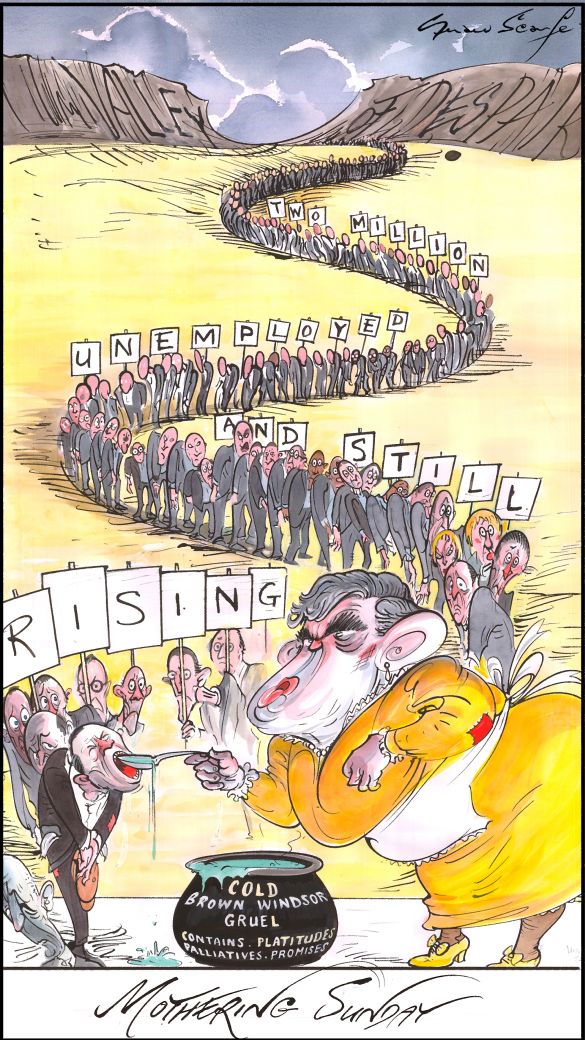
Though it is not evident on the international tourist circuit in the South Island New Zealand is being hard hit, by the global economic crisis. Just like the UK. Both nation states are vulnerable.
March 26, 2009
The Who: nostalgia
I'm returning to New Zealand for a holiday traveling around the northern part of the South Island for ten days or so. A bit of a road trip to places I haven't seen for a long time. So a little bit of nostalgia:
I leave for New Zealand early Friday morning going via Melbourne. As I am not sure about internet access in the northern part of the South Island, I may not be able to post many of the photographs that I've taken. However, I will try to do so as much as I can, posting here and on Flickr.
Update.
The flight from Adelaide via Melbourne to Christchurch was uneventful.The Financial Press in Australia may be saying that Virgin Blue is struggling, but the flight to Melbourne and onto Christchurch was over two thirds full. The planes had a nice easy chatty atmosphere---so different from the formality of Qantas. I guess we were what is known as transit cattle in the trade.
March 25, 2009
Street art: The ABC on
There is an exploration of the issues surrounding graffiti and street art on the ABC's Radio National by Brendan Trembath. It is entitled Graffiti, art and fear. Adelaide was not mentioned---only Sydney and Melbourne:
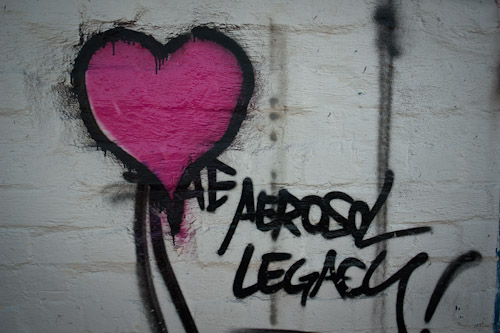 Gary Sauer-Thompson, purple heart, Waymouth Street, Adelaide CBD, 2009
Gary Sauer-Thompson, purple heart, Waymouth Street, Adelaide CBD, 2009
Dr Lachlan MacDowall from the Centre for Cultural Partnerships at the University of Melbourne says that graffiti in Australia in a way goes right back to the indigenous inhabitants of the land. They've obviously adapted the landscape and marked the landscape in all sorts of ways. There's also traces of 19th century graffiti in Melbourne on some of the bluestones, and traces of some of the convict years in Melbourne.
He adds:
But I guess the real heydays of graffiti is in the post-war years where we can still see today some examples of political graffiti from the '60s and '70s, graffiti protesting the Vietnam War or changes in Australian politics. But the key date really for graffiti in Melbourne is in the 1980s when some of the graffiti traditions from New York arrive in Australia via music video clips or films, the documentary films of the New York subway graffiti. And that's the form that becomes dominant over the last two decades. And it's the form that Australian artists have adapted and adopted for their own planet interests. And more recently we've seen I guess, a return to more politicised graffiti and the rise of stencil graffiti in Melbourne, since the turn of the century's been well documented. And we're now at a phase I think of seeing a collision of some of these styles, some of the old-school tagging and mural graffiti up against some of the newer, more figurative and perhaps more political forms of stencil graffiti.
Andrew Mac, who has a gallery overlooking Hosier Lane in Melbourne, says that in the recession years of the early 1990s as young artists we wanted to expose our art to a lot of people and I guess that was inspired a lot by graffiti and street artists use of the street.
It's about kind of taking back public areas in order to show your work and reach a larger audience than you can inside a gallery......At the time I found building owners to be very amenable to the idea. These were back walls in alleyways, and I think people forget these days, because the alleyways are so used in Melbourne, they've become the focus of the city in fact. But in the early '90s they were still considered rat-traps and places where people just put the rubbish. So nobody really cared about their back walls, and I found the building owners quite happy to give us use of the back walls.
He adds that I think people often get caught up between graffiti as vandalism and graffiti as art. Not all graffiti is art, but not all graffiti is vandalism either.
March 24, 2009
viral life
Pollution originates from sewage works at the coast and from fertiliser or pesticides washed into rivers, which then flows down to the sea. The Inman River in Victor Harbor is an example, as the river is primarily a drain for treated effluent from a sewage treatment plant
This results in the physical alteration and destruction of habitats; excessive inputs of nutrients, causing rapid phytoplankton and algal blooms to grow, starving sea life of oxygen changes in sediment flows and has a negative impact on human health--- ear, nose and throat problems, gastro-enteritis or even hepatitis A. "There are tentative suggestions of a link between sewage and viral encephalitis, and also meningitis.
Though the water from the new water treatment plant is 'A Class' quality, its release into the river is unlikely to impact on the water quality of the Lower Inman. The nutrient rich sediments from the old treatment plant may cause water quality concerns in the Lower Inman for many more years and the Inman Riiver will never again be a pristine river and estuary.
The offensive odours in the Lower Inman, which are most noticeable in warm weather, are caused by a remobilisation of the high nutrient levels in the river bed mud sediments during summer and autumn. The stratification of the water column and low dissolved oxygen levels exacerbate the remobilization processes and lead to potential odour and algal issues.
March 23, 2009
street politics
Surprisingly, I took few photos in Melbourne, even though I spent a most of Friday, part of Saturday and a large part of Monday walking the back alley's in the CBD seeing the city from the perspective of an art that understood our future to be open ended one of becoming.
I couldn't post over the weekend because the internet connection at my sister's place in Safety Beach, on the Mornington Peninsula, was down. I shot no landscape work even though I visited Cape Schanck ----it is part of the Mornington Peninsula National Park---on Sunday afternoon. I was much more at home in exploring the little laneways of the western side of the CBD--- the area from Spencer Street to Swanston Street between Collins and LaTrobe Streets.
This is an art that rejects beauty and right feeling, and is an endless, directionless process of goalless experimentation in all that is possible; one made by playful artists disenfranchised by academia, whose ressentiment flows from having little financial security, who survive on casual teaching and part time projects, and are experimenters who see the world in terms of becoming, change decay and death. This is an art that is concerned with suffering---or rather the tragic as suffering---whilst affirming life.
Yeah, it is seeing Melbourne through the eyes of Nietzsche: that “intricate relation” between opposites, such as bliss and pain, that simultaneously unites them and holds them apart with the transitoriness of the world of becoming. An aesthetic that is based on the rejection of the Kantian notion of aesthetic disinterestness focused on the viewer in favour of perspectival seeing and the revaluation of art
March 21, 2009
in Melbourne
I'm in Melbourne this weekend so I thought that this cartoon might be appropriate, since the conservative, Family First Senator Fielding is from Victoria. The Spooner cartoon is a reworking of John Brack's painting The bar, which the National Gallery of Victoria had recently bought the work for $3.2 million from Tasmanian millionaire and collector David Walsh.
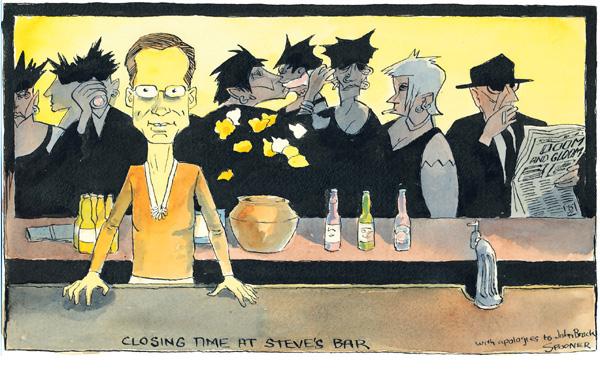
I'm here to meet Flickr friends/collegues associated with Altfotonet, see family, explore the urban life of Melbourne's CBD, and take some photos.
Painted in 1954, The bar depicts the ‘six o’clock swill’ of Melbourne pubs in the 1950s, where patrons hurried to drink their fill before closing time. Tthe painting, in turn refers to Edouard Manet’s famous work of 1881, A bar at the Folies-Bergère, and it shares with it the pictorial device of a mirror behind the bar that reflects the drinkers on the other side.
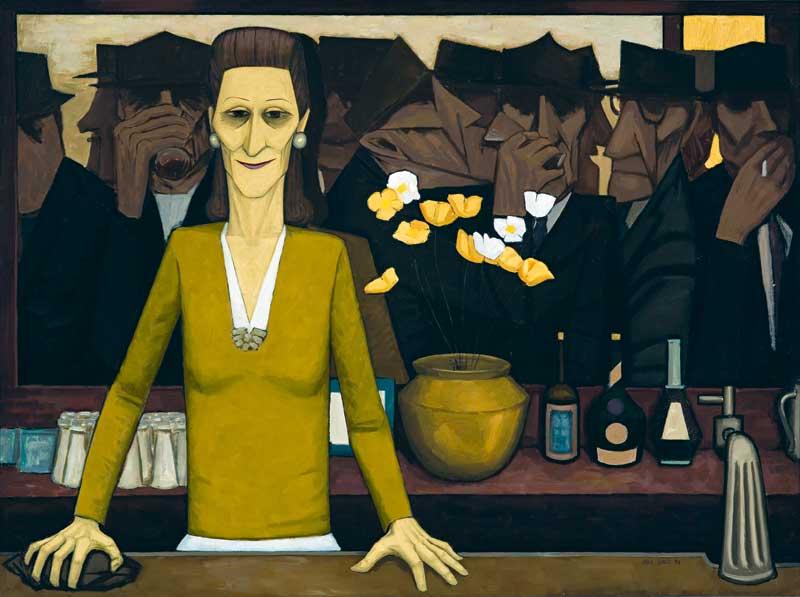 John Bracks, The Bar, 1954, oil on canvas
John Bracks, The Bar, 1954, oil on canvas
This interior view finds its counterpoint in Collins St, 5pm 1955, which depicts crowds of office-workers at the end of the working day marching dutifully toward the trains and trams that will take them home to the sprawling suburbia of mid-century Melbourne.
The inference of the Spooner cartoon? Fielding and Family First stand for 1950s Australia in the 21st century.
March 20, 2009
Kruspit + post art
In The End of Art Donald Kuspit argues that art is over because it has lost its aesthetic import. Kuspit is a follower of a conservative apotheosis of modernist abstraction theorised and championed by the influential American art critic Clement Greenberg. Art has taken a wrong turn, gone off the rails. Kuspit's view that modernism good, postmodernism bad is similar to that of Hilton Kramer at The New Criterion.
Art, Kruspit argues, has been replaced by ‘postart’, a term invented by Alan Kaprow, as a new visual category that elevates the banal over the enigmatic, the scatological over the sacred, cleverness over creativity. Tracing the demise of aesthetic experience to the works and theory of Marcel Duchamp and Barnett Newman, Kuspit argues that devaluation is inseparable from the entropic character of modern art, and that anti-aesthetic postmodern art is its final state. In contrast to modern art, which expressed the universal human unconscious, postmodern art degenerates into an expression of narrow ideological interests.
'Postart' -is a visual-arts category devised by Allan Kaprow, which Kuspit uses to pejoratively describe artworks (invariably postmodern) that express a rejection of the forms, methods, inspirations and aspirations of classical and modern art and therefore can no longer be called artworks in the true sense. Crucially, postart is art that blurs the distinction between everyday life and art. He says about the concept of “postart” simply put,
involves the “blurring of the boundary between art and life,” to use the title of his collection of essays. I would add, based on his idea that life is much more interesting than art, at the expense of art. I think postart is the gist of postmodernism, as the view that it involves the blurring of the boundary between avant-garde and kitsch suggests.
Kuspit adds that the integration of thinking and feeling remains a general issue of selfhood, all the more so in modernity, when the split is celebrated and thinking elevated over feeling. This occurs in art with the split between minimal-conceptual art and expressionism, with the former regarded as inherently superior to the latter.
If the visual arts are to be saved, then according to Kuspit the New Old Masters - a group that includes Lucien Freud and Jenny Saville - will be their saviours. The New Old Masters embody values that simultaneously evoke the spirituality and humanism of the Old Masters and the innovation and criticality of the New Masters, enabling them to transcend the suicidal intellectualism and socio-political fixations of postart.
So we have the claim that the rampant irony of post-modern art, combined with its obsessive navel-gazing, has turned it into a suffocatingly hermetic and an almost irrelevant enterprise. Missing from this is any ? From the this is postmodern theory's ideas of metaphor, deconstruction, transposition, recombination, and bricolage.
March 19, 2009
Talking Heads: More Songs About Buildings and Food
This track-----The Girls Want to be with the Girls---- is from Talking Heads' second album, More Songs About Buildings and Food (1978). It is the first of their string of three Brian Eno-produced records after their emergence out of the New York punk scene that produced the Ramones and Blondie into New Wave.
It is quirky music by an art band, with a brittle sound, in which the music appears to be assembled like an abstract painting and it is before the band wandered onto the African and Brazilian paths that would drive the groove deeper and sometimes brighter.
The eclecticism of More Songs about Buildings and Food centres around its witty distillations of disco and reggae rhythms, its merging of "art" and punk rock. The lo-fi sound and simple instrumentation with tight funk rhythms.
This arty but danceable music appeared before the Labor Decade in Australia when the large record companies were the gatekeepers of the world's popular music andpeople were searching for alternatives to modernism. The cover of the album m appeals because of the Polaroid photography that refers to the style of David Hockney:

The Heads were never really punk judging by that art work.
March 18, 2009
Anselm Kiefer
Anselm Kiefer is a German photographer, painter and sculptor who engages with history and the trauma experienced by societies. His work reflects upon and critiques the myths and chauvinism which eventually propelled the German Third Reich to power. His paintings depict his generation's ambivalence toward the grandiose impulse of German nationalism and its impact on history.
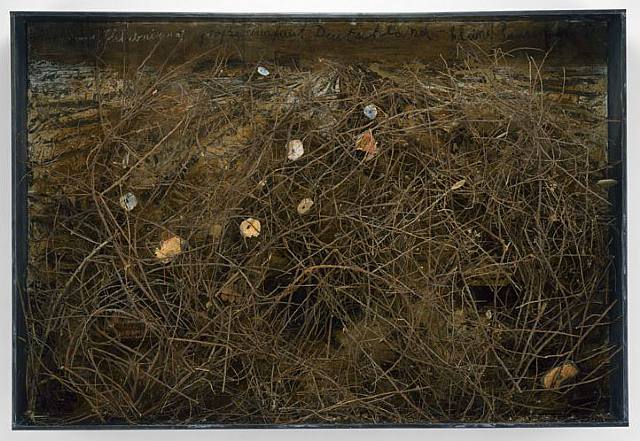 Anselm Kiefer, Grosse Eisenfaust Deutschland kleine Panzerfaust D, mixed media
Anselm Kiefer, Grosse Eisenfaust Deutschland kleine Panzerfaust D, mixed media
He uses a in a variety of materials, including oil paint, dirt, lead, models, photographs, painted photographs woodcuts, sand, straw and all manner of organic material. By adding found materials to the painted surface of his immense tableaux, he invents a compelling third space between painting and sculpture. He uses barren landscapes to explore Germany's past and present.
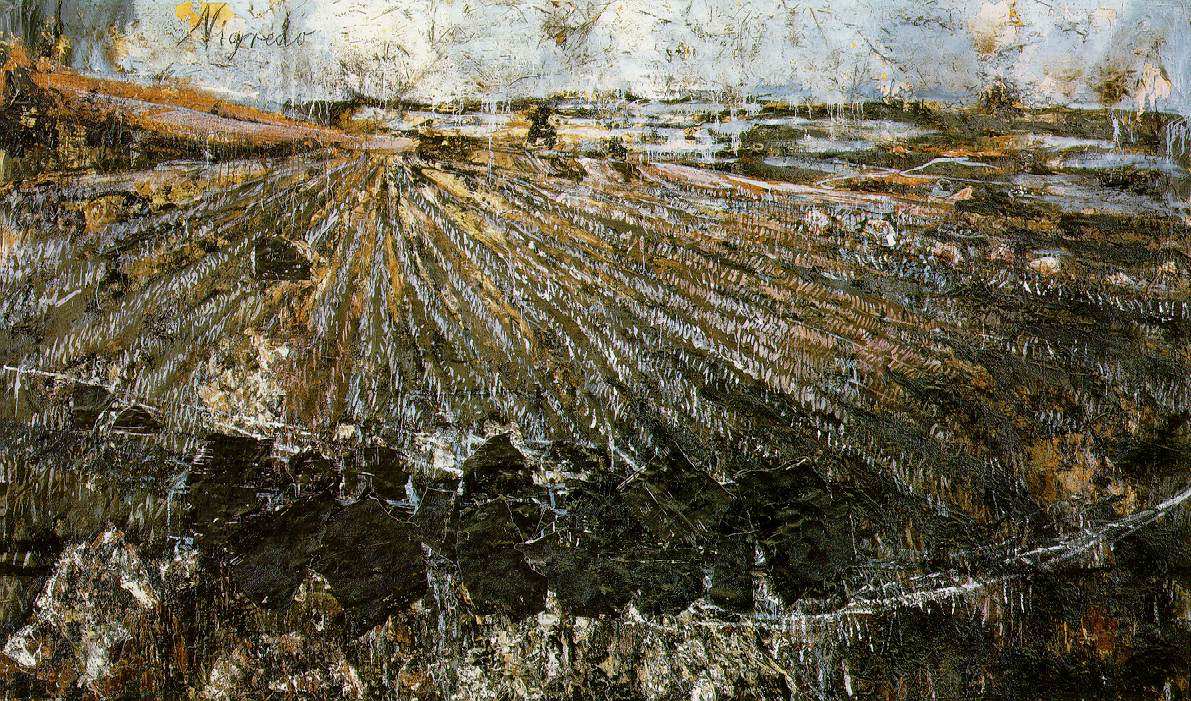 Anselm Kiefer, Nigredo,1984, Oil, acrylic, emulsion, shellac, and straw on photograph, mounted on canvas, with woodcut
Anselm Kiefer, Nigredo,1984, Oil, acrylic, emulsion, shellac, and straw on photograph, mounted on canvas, with woodcut
His concept of an art that synthesizes all the mediums and which sees through illusions to a reality in which Germany's failed to spiritually renew itself in the aftermath of World War 11.
March 17, 2009
German photography: Karin Apollonia Mueller
Karin Apollonina Müller has an interesting project entitled On Edge, which is described as an interest in "how the earth crumbles away and how in our desperate attempt we are trying to control or hide the subtle invasion of nature in cultivated space."
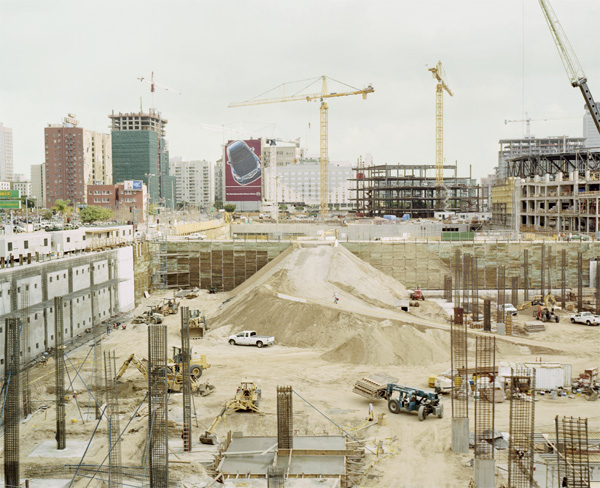 Karin Apollonina Müller, staples, from the 'on edge' series.
Karin Apollonina Müller, staples, from the 'on edge' series.
Karin Apollina Muller lives and works in California, and Germany and my interest is more the urban aspect of On Edge--her studies of LA: the sprawling city scape, the development, the billboards within the nature/urban interface.
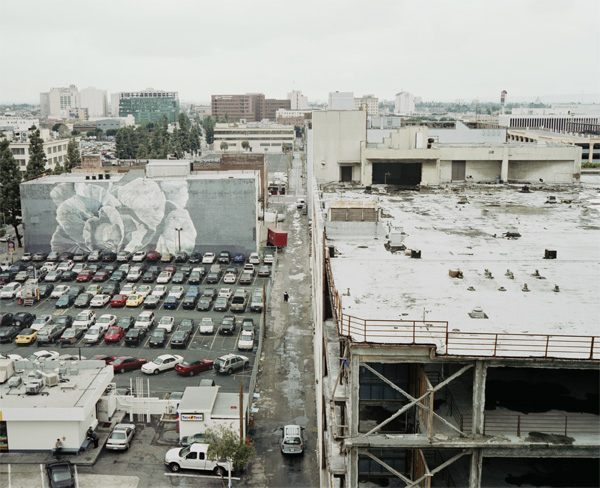 Karin Apollonina Müller, taco taco, from On Edge
Karin Apollonina Müller, taco taco, from On Edge
The perspective is a bird's eye one that looks across the city from on high, rather than the walking the street perspective. The colours are soft and muted, the pictures of the non-CBD area are impressionistic --the LA haze?--the light is flat and the skies overcast. There is a nagging sense of desolation, ennui, with the viewpoint that of a visitor or stranger.
March 15, 2009
The New Media
The New Media Reader says the new media refers to the computer or digital medium that is intended to be "read" on a screen or through other electronic devices. It draws on many antecedents, is spawning a variety of formats and is underpinned by the technologies actively used today: the internet, MP3s, digital film, P2P clients, recent video games or (not unexpectedly) blogs.
In the Introduction Janet H. Murray says the term "new media":
is a sign of our current confusion about where these efforts are leading and our breathlessness at the pace of change, particularly in the last two decades of the 20th century. How long will it take before we see the gift for what it is—a single new medium of representation, the digital medium, formed by the braided interplay of technical invention and cultural expression at the end of the 20th century?
Is it the digitalization of existing media, such as photography? Or something new? The latter---new cultural objects enabled by network communication technologies. An example is video games. it suggests that the computer is not merely a tool used to accomplish tasks, but an object that enters our individual and social lives; how we interact with computers influences our outlook on the world and our perspective on ourselves.
Lev Manovich says that the art institution lagged behind the rest of the cultural and social institutions in dealing with new media technologies, adding that:
This resistance is understandable given that the logic of the art world and the logic of new media are exact opposites. The first is based the romantic idea of authorship which assumes a single author, the notion of a one-of-a-kind art object, and the control over the distribution of such objects which takes place through a set of exclusive places: galleries, museums, auctions. The second privileges the existence of potentially numerous copies; infinitely many different states of the same work; author-user symbiosis (the user can change the work through interactivity); the collective; collaborative authorship; and network distribution (which bypasses the art system distribution channels).
March 13, 2009
Timothy O'Sullivan + American modernism
According to Britt Salvesen in Surrealistic and disturbing’ Timothy O’Sullivan as Seen by Ansel Adams in the 1930s in the Journal of Surrealism and the Americas the canon of American straight photography was formed against the competing aesthetics of pictorialism and experimental formalism. It pointed to models from the past such as O’Sullivan to prove that photography had always been, or was inherently, straight and realistic.

Timothy O'Sullivan: South side of Inscription Rock, New Mexico, 1873, originally uploaded by trialsanderrors.
South side of Inscription Rock, N.M. Photograph by Timothy H. O'Sullivan, 1873, as part of the series "Geographical explorations and surveys west of the 100th meridian", sponsored by the United States War Department, U.S. Army Corps of Engineers.
Beginning with Ansel Adams and Beaumont Newhall, Sullivan has been associated with the achievement of something beyond vulgar realism, that is, mere recording or description. His was the “primitive eye” or “natural vision”. This innocence implied no knowledge of the conventions of realism. Yet Sullivan was also seen as an artist by Adams and Newhall.Salvesen says that Adams and Newhalll were concerned to establish photogpraphy's independence from painting, its truthfulness, its capacity to depart from ordinary perception and stimulate insight, and its Americanness.
March 12, 2009
corporate modernism
This is a new building in Gouger Street in the CBD of Adelaide. It's classic modernism done in 2008-9, and it shows the staying power of modernism as a style of corporate architecture. Modernism still rules for the corporate world it says. Neo-modernism still stands for the deconstruction of urban complexity.
Not quite. When the post-war economic boom faded during the 1970s and many metropolitan areas experienced stagnation, if not decline in population, there was a simultaneous reinvigoration of interest in urban centers resulted from the transition to a post- industrial economy and the emergence of social groups more attracted to inner urban, rather than suburban, amenities. Not so in Adelaide. That happened 30 years latter.
According to Jan Scheurer in this article that the urban district is mono-functional, either:
accommodating commercial or industrial or recreational uses but seldom a mix of more than one. The streetscape is determined by the function of movement while its historic role as a meeting place is pushed aside... The building, formerly designed with ersatility in mind to facilitate changes in usage over time, is now perfected to fit its original purpose but often poorly equipped to accommodate another should future necessities demand this.
The CBDs have commonly tended towards retail- and office-dominated monocultures during the modernist era and the level of public life was not seen as the lifeblood of the urban environment. Consequently, the strengthening of the residential component in the CBD represents a movement away from the modernist city.
This more compact city, with its improved conditions for walking and cycling and the concentration of uses around public transport, is in conflict with the political and cultural acceptance of the dominance of auto mobility, car ownership and traffic flows.
March 11, 2009
Ed Ruscha: photography
Ed Ruscha's body of work, including his photographic books of the 1960s and 1970s, explored the American landscape especially the impassive iconography of the road by often he linking the verbal and the visual. Ruscha explores the place of words in our visual culture and the strangeness of the ordinary, asking us to look anew at the astonishing things we ignore on a daily basis.
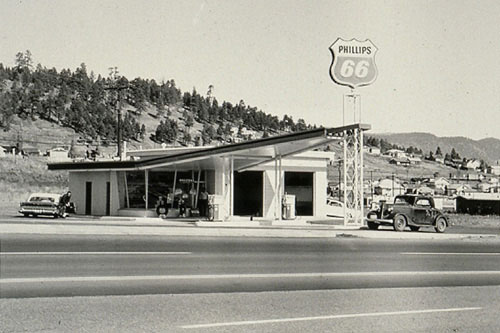 Ed Ruscha, Gasoline station, gas station on Route 66, From 'Twenty Six Gasoline Stations', 1962
Ed Ruscha, Gasoline station, gas station on Route 66, From 'Twenty Six Gasoline Stations', 1962
Ruscha's 'Twenty Six Gasoline Stations' offered an alternative to the humanist concerns of the street photographers. The work was about things rather than about people; surface rather than soul; not the human drama of the street but the taken for granted backdrop of the built enviornment against which the drama plays out. Ruscha’s gasoline work influenced the New Topographics photographers who came to prominence in the mid-70’s.
His work subtly blend major artistic movements of the twentieth century, including Pop, Surrealism, and Minimalism, with the imagery and vocabulary of engrained west coast pop culture. Ruscha mounted a motor-driven 35mm camera on a car and drove up and down Sunset Boulevard in Los Angeles making the photographs that became his 1966 book Every Building on the Sunset Strip.
March 10, 2009
Eric Tabuchi: abandoned Gasoline stations
Eric Tabuchi's work---26 Abandoned Gasoline stations ---is a representation of abandoned, rusting, toxic-leaking architectural ruins that blight the landscape and roadscapes of France. Tabuchi photographed these abandoned gasoline stations between 2002 and 2008 in a flat, objective style, showing them just as plainly as they exist.
The pictures signify the decline of an auto civilization based on cheap petrol.
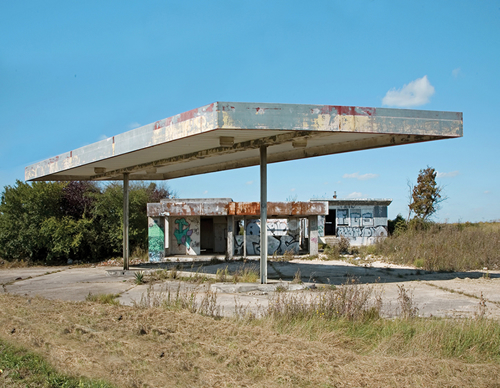 Eric Tabouchi, Station #11, from the series 26 Abandoned Gasoline stations, circa 2002-2008
Eric Tabouchi, Station #11, from the series 26 Abandoned Gasoline stations, circa 2002-2008
The art photography reference is to Twentysix Gasoline Stations, one of the first American artist books, by the pop artist Ed Ruscha. The book was a small paperback containing pictures of gas stations dotting U.S. Route 40, the road between Oklahoma City, where the artist grew up, and Los Angeles, where he lived and worked in the 1960s. It had minimal text and was arranged so that the reader's progress through its pages is similar to a traveler's journey from Los Angeles to Oklahoma City and back.
Ruscha's book was the Pop-Minimalist vision of the Road. Jack Kerouac had written about the ecstatic, beatnik Road. Ken Kesey and Neal Cassady had written about the acid-hippie Road. Ruscha had photographed the road through realms of absence - that exquisite, iterative progress through the domain of names and places, through vacant landscapes of windblown, ephemeral architectural language.
Photography books have become a natural extension to the photographic process, and are shaping the future of photography as we know it. Long gone are the days where only professional and internationally renowned photographers could publish their work. With print on demand technologies, all photographers can create bound collections of their work, while retaining full control of the creative process – forever changing the face of publishing.
March 9, 2009
Captain Beefheart: Safe as Milk
Courtesy of terr0rkitten an English photographer whom I came across on Flickr. He runs a photoblog. I really admire his work. His video selection, 'I'm Glad", is from Captain Beefheart and The Magic Band's 1967 debut album, Safe As Milk.
Beefheart can be seen as one of the truly independent artists in late 20th century rock music.
The album is blues/rock with an edge with little indication of how Beefheart's music would exceed that musical form and its historical context; or the links back to Dada.
March 8, 2009
modernism + contemporary
The usual story of Modernist art: that it was smashed by Fascism and totalitarianism in prewar Europe, then triumphally restored in postwar America as the analogue of American Freedom. The recovery of Modernism in the form of ‘the Triumph of American Painting’ is interpreted as cultural compensation for the devastation of Europe. A strong version of this story, affirmed by Rubin at MoMA, was developed by Clement Greenberg, for whom advanced abstraction did not break with the artistic past but preserved its greatest qualities through self-critique.
Such ‘Modernist painting’ served, then, not only to bracket other avant-garde practices, which indeed posited a break with tradition (the readymade, constructed sculpture, the found image, collage, photomontage), but also to paper over historical rupture as such: in effect, this account concentrated history on one medium, abstract painting, which provided a sense of continuity not to be had elsewhere. This high culture narrative was counterposed to the deep ‘distaste for the cheap amusements and common spectacles that make up mass culture’, the corporate merging, culture marketing and the franchising (the Star Wars industry). It was distaste and hostility because culture is entertainment, and mass culture was deemed to be the realm of the inauthentic.
Today, when the divides between high and low culture, Modernist and mass art are disappearing, the split between Modernist art and contemporary practice widens every day at museums like the Guggenheim, Tate Modern, MoMA and the Pompidou. In 1929 there was no divide between Modernist and contemporary. Similarly in 1949. Not so in 2009 --- today it is clear that the Modernist and the contemporary have parted company. Thus the the large painterly photograph and the even larger projected image, both of which are often treated digitally, have become international idioms, and point to a paradox whereby, even as ‘the cinema’ is declared dead, ‘the cinematic’ now appears almost everywhere: in computer games and TV adverts, on building façades.
This form is taking place in the context of a far more penetrative register of media, market, and war and empire that we have come to naturalise as ‘globalisation’ than that of the early modernists in the first half of the 20th century. In this context the new culture and marketing is just another version of ‘the culture industry’ outlined by Adorno and Horkheimer more than fifty years ago? Culture and marketing of the Star Wars type is just another version of ‘the culture industry’ outlined by Adorno and Horkheimer more than fifty years ago.
One could identify three phases of this industry in the 20th century: the first in the 1920s as radio spread, sound was connected to film and mechanical reproduction became pervasive (Debord identified this as the formation of ‘spectacle’); the second in the postwar perfection of a consumer capitalism (with its image world luridly exposed by Warhol); and the third, perhaps, in the digital revolution and dot.capitalism of today.
March 5, 2009
Lewis Baltz: the question of the medium
In this interview at American SuburbX the American photographer Lewis Baltz says:
I've never had any profound loyalty to the idea of photography as a medium but simply as the most efficient way of making or recording an image. And that has changed over the last few years. Now the most efficient way is to work with digital or with digital-analogue or between the two. Eventually, I'm sure it will be entirely digital. It's simply the prevailing technology, the available technology now. I think in the future we won't even have a choice.
Baltz’s early black and white photographs depict the architecture of the urban landscape, and were often displayed in Minimalist grid-like structures. Devoid of human presence, these images of blank concrete walls and characterless buildings suggested abstract paintings. Some of the minimalist pictures included nature:
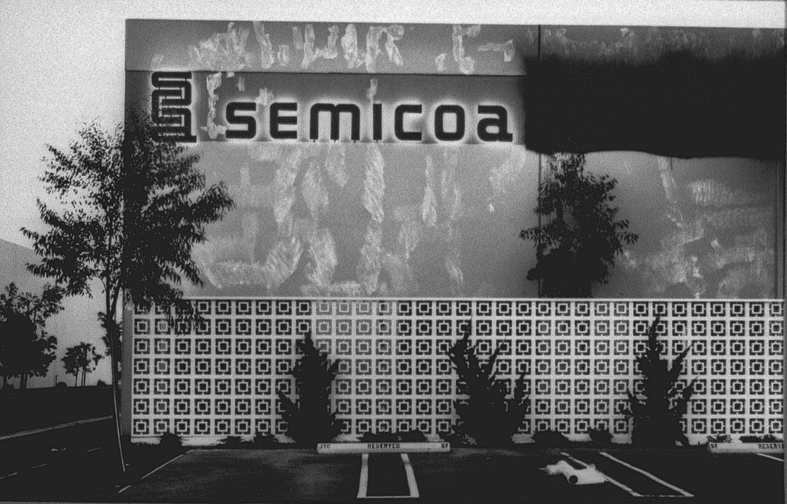 Lewis Baltz, North Wall, Semicoa, 333 McCormick, Costa Mesa, from the series New Industrial Parks, 1974
Lewis Baltz, North Wall, Semicoa, 333 McCormick, Costa Mesa, from the series New Industrial Parks, 1974
His early "topographic work", such as The New Industrial Parks, Nevada, San Quentin Point, Candlestick Point (84 photographs documenting a public space near Candlestick Park, ruined by natural detritus and human intervention), exposed the crisis of technology and urban life. The pictures describe the architecture of the human landscape, offices, factories, and parking lots. My interest is in the Candlestick Point work:---a series devoted to an area near San Francisco that urban renewal had overlooked. This is a landscape defiled by human waste.
 Lewis Baltz, National Centre for Meteorological Research, Grenoble, circa 1989-91 from series Sites of Technology May 17 - Jul 15, 2008
Lewis Baltz, National Centre for Meteorological Research, Grenoble, circa 1989-91 from series Sites of Technology May 17 - Jul 15, 2008
Sites of Technology traces Lewis Baltz’s journey through the workplaces of information technologies in Europe and Japan in the early 1990’s. In the interview Baltz goes on to observe that:
The questioning of the photograph in its relation to the reality, the interrogation of representation, the famous crisis of representation, really all took place before digital technology. Digital technology, you see, is not the villain here. It simply offers another dimension. I'm not sure if it's a farther remove from reality than analogue. I think if we can speak of reality, if reality and representation can be spoken of in the same sentence, if reality even exists any more, digital is simply another way of encoding that reality. I don't think it's farther from or, for that matter, closer to this concept of reality than anything that came before. I don't think the question of "materiality" is really what's at issue here. Photography is less material than painting; digital is less material. But the dematerialisation of art again is something that began thirty years ago as a conceptual gesture and long before people realised that it was not only a possibility but would in fact become the dominant technology.
He says that the contemporary artists simply take for granted that all these mediums such as computer, video, photography, film are available and have their particular qualities. Consequently, they modernist question of medium is something that seems to be disappearing.
March 4, 2009
Grateful Dead: Europe 72
The Grateful Dead performing China Cat Sunflower Jam - I Know You Rider on their Europe '72 tour in Copenhagen, Denmark. At that time people were confused about this sixties' band. Were they a country, cowboy band? A psychedelic band? A neo-folk band with rock pretensions? Or were they the sometimes jazzy, almost slick band. Or just a bunch of aging hippies. Aesthetic identity was a problem.
Europe '72 was a triple live album; an ambitious one as it presented new songs, two long jams, a reworking of their old songs and interpretations of traditional or classic songs. It is in the middle of a period of creativity that started with Live/Dead (1970) and ended, four years later, after seven albums and various solo projects that was one of the most sustained periods of creativity for any sixties' rock band.
It was around this time that the process of the band being overlooked and underrated by the rock press (Dave Marsh, Robert Christgau, Greil Marcus, Lester Bangs) got underway. What was dismissed was the ensemble playing in the very extended improvisational pieces often in an unusual form-of-jazz format.
March 3, 2009
Iain Sinclair + psychogeography
The word Psychogeography' comes from DeQuincey's wanderings, slightly druggy, no pattern, mapping out the city in a dream-like state. Then with Walter Benjamin and the Situationists the term becomes more a matter of taking very conceptual decisions about the walking you would do and how you would access the city like that. So says Ian Sinclair. He forgets to mention both Friedrich Engels', On the Condition of the Working Class in England that was based on his detailed descriptions of his walks around Manchester in the 1840s and the Surrealists dérive, the aimless drifting, the idea of following your unconscious drives to walking across the city.
How is this different from just wandering the street, sitting in cafés and watching the world go by whilst chatting to friends over coffee? Sinclair says:
For me, it's a way of psychoanalysing the psychosis of the place in which I happen to live. I'm just exploiting it because I think it's a canny way to write about London....I can't live in Hackney. ... Nothing working, completely shot council, the banality of gradual dysfunction, the sense of the landscape becoming more intimidating.
Still he writes about it, describing what has happened to London and it environs over the last few decades, thereby drawing people’s attention on what’s happened to the city. Why not photographers doing this? After all, we Atget’s city and his photography of old Paris.
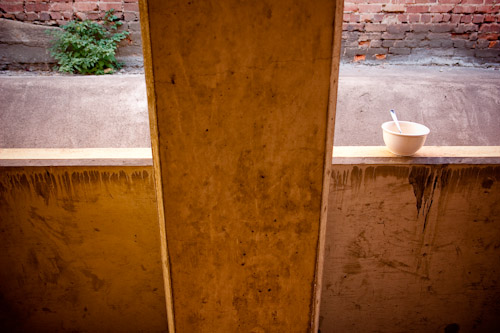 Gary Sauer-Thompson, Young Street carpark, 2009
Gary Sauer-Thompson, Young Street carpark, 2009
After all, psychogeography is the point where psychology and geography meet in assessing the emotional and behavioural impact of urban space. The relationship between a city and its inhabitants is measured in two ways - firstly through an imaginative and literary response, secondly on foot through walking the city, which is what I do daily. like the recitation of an urban myth, pushing the boundaries of the plausible. Under the physical erasure of urban planning that works hand in glove with developers the city’s past takes refuge in receding memory, often appearing through urban legend.
Merlin Coverley, who has written a book on Psychogeography, says that:
History shows that through literature there is a particular way of responding to the city and its environs. Many ways really, but there is one common theme: that if you scratch beneath the surface you can find something else: the different layers, the mapping, the essence of any city is in its oddities, its peculiarities, the particularities of its places, a sense that all this is being continually erased, not just in London, but everywhere, globalisation in particular. There is a sense that this is happening and people are buying into it without any real awareness of what’s being lost in the process.
Psychogeography provides us with new ways of apprehending our surroundings, transforming the familiar streets of our everyday experience into something new and unexpected in a globalised world. Sinclair tackles spatial change and politics within cities at a time when the welfare state is being destroyed and the dream of London’s municipal socialism is being crushed by Margaret Thatcher.
March 2, 2009
photography + the global financial crisis
Simon Norfolk---whom we have met here---- muses on photography's future in the context of the global financial crisis that has pulled the rug under their income and savings. He says that his advice is:
Get re-skilled. Keep your photographic aspirations but try to get a trade like film editing, web-design or accounting. Soon we’ll all be amateur photographers with real money-making jobs on the side that we don’t tell our colleagues about. We need to get over the snobbery attached to that. And we have to be tougher in our demands. Magazines online will be built by re-skilled photography lovers around business plans that don’t include paying wages to the photographers they ask to write. They pay salaries to each other, they pay the man who comes to fix the photocopier, but the "name" photographers they ask to contribute six hundred words get nothing. With business models like that, how can we survive?"
So professional photographer simply means earning a living from doing photography in the marketplace. Hence the contrast with amateur (doing it for fun ) and art photographer as another kind of professional photographer.
Norfolk's phrase "amateur photographers with real money-making jobs on the side "----that sounds like a good description of me. Amateur photographers who represent the effects of the global financial crisis:
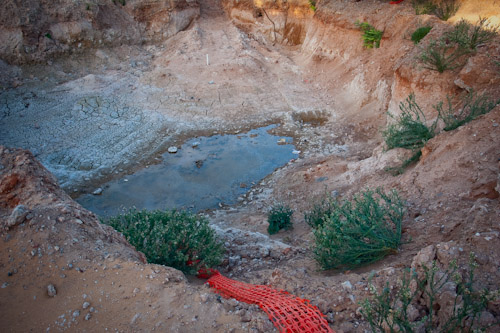 Gary Sauer-Thompson, stalled development, Adelaide CBD, 2009
Gary Sauer-Thompson, stalled development, Adelaide CBD, 2009
The holes in the ground are everywhere in the Adelaide CBD----these are developments both commercial buildings and blocks of apartments or flats. The local media say they are stalled due to a hiccup in the market. The assume that the self-correcting nature of markets will ultimately prevail.
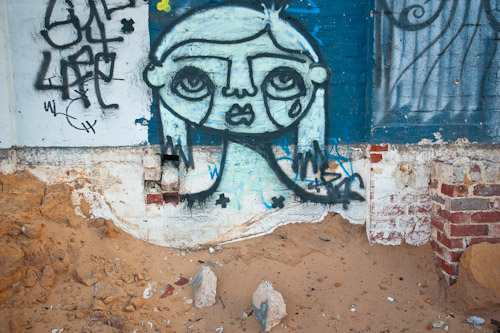 Gary Sauer-Thompson, street art, Waymouth Street, Adelaide, 2009
Gary Sauer-Thompson, street art, Waymouth Street, Adelaide, 2009
The reality is otherwise---all the holes in the ground. Despair slowly seeps in. The shadows cast by depression can be felt behind one as we walk the streets. This is happening just when this rustbelt city was getting back on its feet from the recession of the 1980s.
On the other hand, the globalised internet‐driven ‘future’ is here with its emerging global culture, enabled by an accessible technology, and it is scrambling old business models, even ideas of national identity, whilst at the same time creating new audiences and practitioners at home and abroad.
If the audience is online and anywhere, thenemerging artists are asking, legitimately, why are they seen in terms of government subsidy, rather than as the vanguard of the new digital economy. It is a good question. As Helen O'Neil says the economics of the creative industries mean that artists must learn to live in the world of productivity growth and the knowledge economy as well as the more familiar world of personal f enrichment and revitalisation.



